Soil Sampling
It is that time of year again to be thinking about taking soil samples on your farm.
Remember a soil analysis is only as good as the sample on which it is based. Soil samples should be taken approximately 6 months prior to when you want to plant the crop. This gives you time to get the results back and get a plan established as to what fertilization program you want to apply. There is no magic number for how many cores you should take to form a good sample for the lab; the more cores you take the better representation you will get for the field you are sampling. A good suggestion is to take 10-15 cores for fields under 20 acres, removing any vegetation or crop residue from the surface of the sampling site.
You want to sample to plow layer depth, usually 6-8 inches. You should also take different samples for areas of different soil type and different terrain in the same field. Mix cores thoroughly, breaking up any clods and discarding stones and debris. Be sure to label soil samples in a way that, at a later date, you will be able to link the analysis with the correct field. A good time of year to sample is during the fall after harvest has been completed. You don’t have the pressure of spring time planting, no standing crops to deal with, and fields are usually dry enough to support a four-wheeler or pickup truck. You should sample each field at least once every 3 years; more often if you’re trying to correct serious pH or nutrient deficiencies.
When you send you samples to the lab, you should use the same lab every time, because different labs use different methods which can give you different results for the samples you had taken. When you get the results back from the lab you can go over them with our Soil & Water Agriculture District Technician, your local crop consultant, or the OSU Extension Agriculture Educator to come up with a plan that will work on your farm.
You can also come up with a Variable Rate plan that most fertilizer Co-Ops can do with the new Variable Rate technology equipment they have. This new program lets the farmers apply on the fertilizers to the areas of the field that are deficient and not have an over abundance on other areas of the fields. This technology will also be more cost effective and also make you better stewards of the soils that you farm.
Soil & Water has Soil Probes to borrow to take samples. Contact us to reserve yours today! 740-670-5330 or Information@LickingSWCD.com
Ponds
So, you think you want a pond…?
Ponds dot the landscape of Ohio and have for a very long time. Initially, ponds were created to provide a reserve source of water for the farm to water livestock, provide fire protection, enable fish production, and other purposes. However, in today’s changing land-use landscape, ponds offer a source for recreation, creating wildlife habitat, or improving the aesthetics of a property. There is more to building and managing a pond than digging a hole and grabbing a lawn chair! Some of the things to consider include:
- Are the soils conducive to having a pond? Some soils hold water better than others. A pond can leak due to improper soils, incorrect construction methods, and/or porous geologic formations resulting in a mud hole. Evaluation of the soils at a pond site can determine if a pond is economically feasible. Ponds are expensive; even more so if additional material needs hauled in to seal the bottom. Preliminary information on soils and their suitability can be obtained from the Web Soil Survey (https://websoilsurvey.sc.egov.usda.gov/App/HomePage.htm), or by contacting the Licking County Soil & Water Conservation District at 740.670.5330.
- What is the source of water to fill and maintain a pond? Ponds can be filled and maintained through a variety of water sources including surface runoff, streams, and springs. If surface runoff is the main source of water for the pond, is there a sufficient number of acres to provide the volume of water necessary for the size of pond desired? The Licking County Soil & Water Conservation District can assist in determining the watershed to see if it is suitable for the size of pond being considered.
- What impact will a pond have to adjacent properties? Regardless of the source of water to fill and maintain a pond (springs, runoff, streams), careful consideration is warranted regarding the impact and location of the overflow and emergency spillway. Ohio Drainage Law is complex, but is based on "reasonable use". A landowner may drain surface water from their property in a "reasonable manner". Additional information may be obtained from The Ohio State University at https://farmoffice.osu.edu/blog-tags/ohio-drainage-law and also at https://farmoffice.osu.edu/sites/aglaw/files/site-library/Understanding%20Water%20Rights%20in%20Ohio.pdf. The Ohio Farm Bureau Federation also has information on Ohio Drainage Law at: https://ofbf.org/2014/03/06/five-tips-on-drainage-law/.
- How is the pond going to be managed? While a pond can provide a valuable asset to a property, it must be managed to maintain its contribution as an asset rather than a liability. Several methods exist to manage unwanted or excessive vegetation (algae, cattails, aquatic growth), which include biologic approaches (various species of fish) and chemical approaches (dyes, herbicides, algaecides, etc.). Aeration is another approach that has been shown to improve water quality, increase oxygen in the water, discourage growth of algae, and promotes healthier fish.
- Are permits required? Landowners desiring a pond should check with several agencies to determine if a permit is required. These include the Licking County Planning Department (https://lickingcounty.gov/depts/planning/default.htm, 740.670.5200), Ohio Department of Natural Resources, Division of Water Resources (http://water.ohiodnr.gov/safety/dam-safety/about, 614.265.6620), and the Township Zoning Inspector (if applicable; https://lickingcounty.gov/about/township.htm). Permit requirements are usually determined by the location of the pond (where in the county or municipality, proximity to roads and houses, etc.), whether the proposed pond is in a floodplain, the effect on neighbors and adjacent landowners, and if the pond is dug out or will have a dam.
- Find a reputable contractor. Locate a contractor who has the knowledge, experience, and equipment to build a pond. One question to ask is do they have a sheepsfoot roller and know how to use it. A sheepsfoot roller is used to compact material. The bottom layer of a pond needs to be compacted correctly to enable it to hold water and not leak. The Licking County Soil & Water Conservation District has an incomplete list of contractors; inclusion on the contractor list is not an endorsement over other contractors who may also be qualified.
- Consider incorporating a dry hydrant. A dry hydrant is an unpressurized pipe incorporated into a pond design that enables a hookup to a fire engine pump. The dry hydrant then becomes a source of water for fighting fires. Additional information on dry hydrants is available at: https://www.nrcs.usda.gov/Internet/FSE_DOCUMENTS/nrcs143_026061.pdf and www2.dnr.cornell.edu/cek7/fish/Pond/farmpond/contents/Wisconsin-dry-hydrants.pdf
Landowners desiring a pond can obtain technical assistance and additional information by contacting the Licking County Soil & Water Conservation District at 740.670.5330.
Several additional resources are available to landowners:
The Ohio Department of Natural Resources, Division of Wildlife publishes Ohio Pond Management Handbook, which can be accessed at:
http://wildlife.ohiodnr.gov/portals/wildlife/pdfs/publications/fish management/Pub432.pdf
It contains information on siting and managing a pond, including sections on fish and aquatic vegetation, and troubleshooting existing ponds.
The Ohio Department of Natural Resources, Division of Water Resources hosts information on dams, repairs, permits, and other useful information, and can be accessed at:
https://ohiodnr.gov/static/documents/wildlife/fish-management/Pond%20Management%20Pub432.pdf
The United States Department of Agriculture, Natural Resources Conservation Service publishes Ponds - Planning, Design, Construction and can be accessed at:
https://www.nrcs.usda.gov/Internet/FSE_DOCUMENTS/nrcs144p2_030362.pdf
It contains information on water needs, preliminary investigations, site surveys, etc. There is an abundant amount of technical information; focus on those sections that are relevant to your questions and don’t get lost in the technical information, graphs, and equations.
Fenders Fish Hatchery, www.fendersfishhatchery.com, started in 1959 and provides various species of fish used for stocking ponds. Author Steve Fender discusses ponds, fish species, pond wildlife, and other subjects related to ponds in his book Pond Management The Common Sense Guide, and is available at their website.
Conservation Plans
A conservation plan is a tool designed to help you better manage the natural resources on your farm. Our District technician and NRCS conservationist may be able to meet with you to evaluate the soil, water, air, plant and animal resources on your property and offer several alternative practices to address resource concerns. The practices you choose to use are recorded in your conservation plan which includes a schedule for installation. Implementing the conservation plan will help you protect the environment on and off your farm.
A conservation plan includes:
- an aerial photo or diagram of your fields;
- a list of your management decisions;
- the location of and schedule for applying new conservation practices;
- a soil map and soil descriptions;
- information sheets explaining how to carry out your specific management decisions;
- a plan for operation and maintenance of practices, if needed.
Benefits of a Conservation Plan
Following your conservation plan has many benefits:
- You will protect your soil and your farm’s productivity;
- You will help improve quality of the water in your area;
- You will improve your soil’s fertility and manage soil moisture;
- You may attract desirable wildlife by creating nesting sites and winter cover;
- You will protect the productive value of your land for future generations;
- You can more readily comply with environmental regulatory requirements;
- You may be eligible for USDA farm programs.



